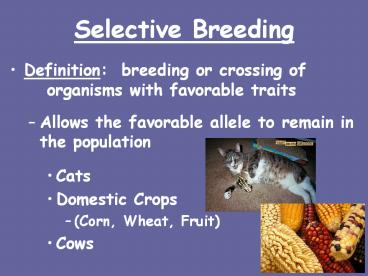Selective Breeding - PowerPoint PPT Presentation
1 / 23
Title:
Selective Breeding
Description:
Selective Breeding Definition: breeding or crossing of organisms with favorable traits Allows the favorable allele to remain in the population – PowerPoint PPT presentation
Number of Views:667
Avg rating:3.0/5.0
Title: Selective Breeding
1
Selective Breeding
- Definition breeding or crossing of organisms
with favorable traits - Allows the favorable allele to remain in the
population - Cats
- Domestic Crops
- (Corn, Wheat, Fruit)
- Cows
2
Inbreeding
- Definition mating of closely related organisms
- Ensures that offspring are homozygous for favored
traits - Greater chance of harmful recessive traits to
appear
3
Hybrid
- Definition the offspring of parents that have
different forms of a trait - Closely related species are crossed
- Most Frequent in Plants (eg. Crops)
- Lion Tiger LIGER!!!
4
How can a breeder determine which organism
(genotype) should be used for breeding?
- By crossing an organism with a homozygous
recessive organism we can determine the genotype
of our dominant individual by examining their
offspring!
5
Test Cross
- Definition a cross of an individual of unknown
genotype with an individual of a known genotype - The known genotype is usually homozygous recessive
In German Shepherds DD or Dd Normal Height
Dog dd Dwarf Dog
6
- If known parent is homozygous recessive (dd)
and the unknown is homozygous dominant (DD)
D
D
Dd Dd
Dd Dd
d
d
All offspring are Dd and show dominant
trait Normal Height
7
- If known parent is homozygous recessive (dd)
and the unknown is heterozygous (Dd)
D
d
Dd dd
Dd dd
d
d
50 of the offspring will be heterozygous and
show dominant trait and 50 will show the
recessive trait
8
Genetic Engineering
- Much faster and more valuable method for
increasing allele frequency (favorable traits) in
a population. - Must cut or cleave the DNA and insert it into
host organism. - Also called Recombinant DNA Technology
9
Recombinant DNA Technology
- Made by connecting or recombining fragments of
DNA from different sources - Transgenic organism organism that contains
foreign DNA - In order to do this you must isolate a fragment
or small part of the DNA using restriction enzymes
10
Restriction Enzymes
- Definition bacterial proteins that have the
ability to cut both strands of the DNA molecule
at specific nucleotide sequences - There are hundreds of restrictions enzymes, each
different in length and specification - Gene Splicing the rejoining of DNA fragments
- join sticky ends of fragmented DNA
11
(No Transcript)
12
Vector
- Definition a means by which DNA from another
species can be carried into the host cell - Can be mechanical or biological
13
Types of Vectors
- Biological
- Viruses
- Plasmid small circular bacterial DNA
- Mechanical
- Micropipette inserts DNA into host cell
- Bullet coated with DNA and shot into nucleus
with gene gun
14
Stem Cells
- Stem cell a cell that can continuously divide
and differentiate into various tissues - Adult humans have stem cells in bone marrow,
these cells can be collected and used for medical
treatments - Stem cells from embryos have much more potential
to develop into new tissues and have more
potential uses
15
Stem Cells Is it ethical?
- Leftover embryos from fertility clinics was main
source for stem cells - Now, stem cells can be cloned
- Which method is more acceptable?
16
Cloning
- Clone organism or piece of genetic material that
is genetically identical to one that was
previously existing
17
Cloning Is it ethical?
18
Applications of DNA Technology
- Animals Used to investigate human diseases
- Mice
- Roundworms
- Fruit fly
- Agriculture
- Strawberries built-in frost protection
- Resistance to herbicides, produce internal
pesticides, and increase protein production
19
Applications of DNA Technology
- Industry
- 1. Bacteria engineered
- to degrade oil
- 2. Bacteria engineered to
- extract minerals from ore
- Medicine Bacteria engineered to
- Produce of growth hormone to treat dwarfism
- Produce insulin for people w/ diabetes
- Making of Aspartame artificial sweetener
20
- Gene Therapy insertion of normal genes into
human cells to correct genetic disorders - DNA Fingerprinting
- Used by law enforcement
- to determine if suspect was
- at the crime scene
- Uses PCR technique
- Especially helpful because
- no two people are genetically
- identical
21
The Human Genome Project
- Organized in 1990, projected to be a 30 year
project, rough completion in 2001 - International effort
- Wanted to map and sequence the HUMAN GENOME
80,000 genes on our 46 chromosomes
22
The Human Genome Project
- Made possible by the use of linkage maps
- Linkage maps genetic map that shows the location
of genes on a chromosome - Helps to also evaluate the rate of crossing-over
23
Why the Human Genome Project?
- Better understanding
- of the human body
- and condition
- Diagnosis of genetic
- disorders
- Identification of suspects in a criminal case































